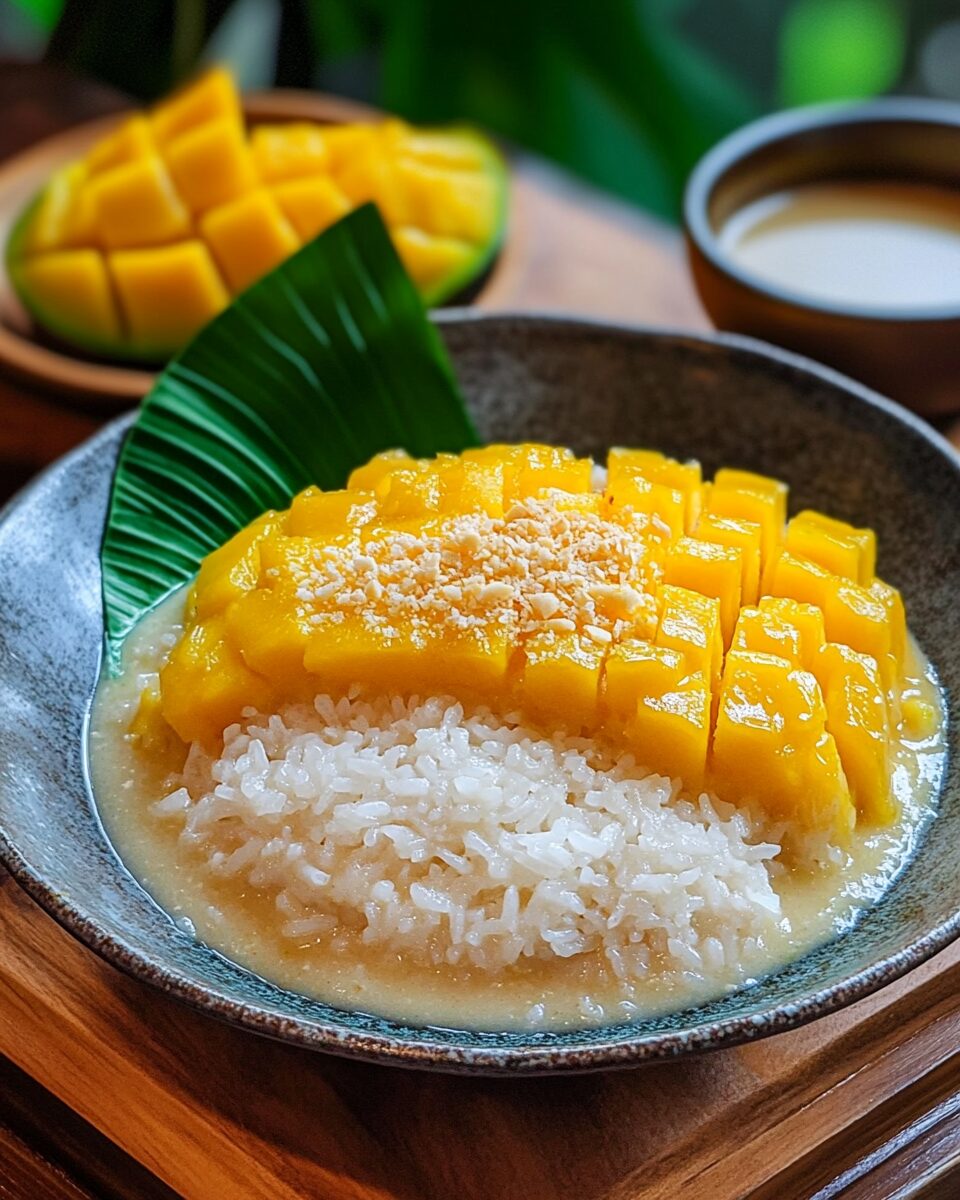Mango Sticky Rice is a popular Thai dessert made with sweet sticky rice, fresh mango, and a coconut-based sauce. The combination of creamy coconut and ripe mango with tender, sticky rice creates a refreshing and indulgent treat that is loved worldwide.
FULL RECIPE
Ingredients
- 1 cup sticky rice (glutinous rice)
- 1 ½ cups coconut milk
- ¼ cup sugar
- 1 pinch salt
- 2 ripe mangoes, peeled and sliced
- 1 tablespoon sesame seeds or mung beans (optional, for garnish)
Directions
- Rinse the sticky rice thoroughly in cold water until the water runs clear.
- Soak the sticky rice in water for at least 1 hour or overnight for best results.
- Steam the soaked rice for about 20-30 minutes until fully cooked and tender.
- While the rice is steaming, in a separate pan, combine coconut milk, sugar, and salt. Heat gently, stirring until the sugar dissolves, but do not boil.
- Once the rice is cooked, transfer it to a large bowl and pour the coconut milk mixture over the rice. Stir well to combine, ensuring the rice is evenly coated. Let it sit for 15 minutes to absorb the coconut flavor.
- To serve, arrange the sticky rice on a plate and top with slices of fresh mango.
- Garnish with sesame seeds or mung beans, if desired.
Nutritional Information
- Calories: 250-300 kcal per serving
- Carbohydrates: 55-60g
- Protein: 3g
- Fat: 7-9g
- Fiber: 2g
The Origins of Mango Sticky Rice
Mango Sticky Rice, known as “Khao Niew Mamuang” in Thai, is a beloved dessert that originated in Thailand. The dish is deeply rooted in Thai culture and is often served during special occasions, such as celebrations and festivals. It is a quintessential example of Thai cuisine, which is known for balancing sweet, salty, sour, and savory flavors. While variations of sticky rice with mango exist in other parts of Southeast Asia, the Thai version is the most famous and widely recognized.
The Cultural Significance of Mango Sticky Rice
Mango Sticky Rice is more than just a dessert; it is a symbol of Thai hospitality and warmth. The dish is often prepared with love and care, making it a staple for gatherings with family and friends. In Thailand, it is particularly enjoyed during the mango season, which runs from March to May. It is also a popular choice during the Songkran Festival, the Thai New Year, when families come together to celebrate with food and festivities.
The Role of Sticky Rice in Thai Cuisine
Sticky rice, or glutinous rice, plays a crucial role in Thai cooking and is an essential part of many Thai meals. Unlike regular rice, sticky rice has a high starch content, which makes it sticky and clumpy when cooked. This texture allows it to absorb the flavors of accompanying ingredients, such as coconut milk, and stick together in a cohesive way. Sticky rice is often served alongside savory dishes like grilled meats or used in desserts like Mango Sticky Rice.
Variations of Mango Sticky Rice Around the World
While Mango Sticky Rice is traditionally associated with Thailand, other countries in Southeast Asia have their own versions of this iconic dessert. In Laos, for example, the dish is similarly made with sticky rice and mango but may be served with different garnishes or flavored with additional ingredients like pandan. Other countries, such as Cambodia and Vietnam, have also adopted this dessert, though the preparation and presentation may vary slightly from the Thai version.
The Simplicity of the Dish
One of the reasons Mango Sticky Rice is so beloved is its simplicity. The dish requires only a few basic ingredients: sticky rice, coconut milk, sugar, and ripe mangoes. Despite its simplicity, the combination of these ingredients results in a dish that is incredibly flavorful and satisfying. This minimalist approach to cooking is a hallmark of Thai cuisine, where the focus is on using fresh, high-quality ingredients to create delicious, balanced dishes.
The Texture Contrast in Mango Sticky Rice
One of the most appealing aspects of Mango Sticky Rice is the contrast in textures. The soft, slightly sticky rice contrasts beautifully with the smooth, juicy mango slices. The coconut milk-soaked rice is tender and creamy, while the fresh mango adds a burst of sweetness and a refreshing juiciness that balances out the richness of the coconut milk. This textural contrast is what makes the dish so enjoyable and adds to its overall appeal.
Seasonal Appeal of Mango Sticky Rice
Mango Sticky Rice is typically made during the mango season, which runs from March to May in Thailand. During this time, mangoes are at their peak ripeness, offering the perfect balance of sweetness and juiciness. While the dish can be enjoyed year-round, it is particularly popular during the mango season when the fruit is freshest and most abundant. This seasonal connection adds to the dish’s charm and makes it feel even more special when served during this time.
How to Achieve the Perfect Sticky Rice
Achieving the perfect sticky rice for Mango Sticky Rice requires a little technique and patience. The rice must be soaked for several hours or overnight to achieve the right texture. This soaking step is crucial because it allows the rice grains to absorb moisture, ensuring they cook evenly and become tender without being overly soft. Additionally, steaming the rice rather than boiling it helps maintain its sticky consistency and prevents it from becoming too mushy.
Balancing the Sweet and Salty Flavors
Mango Sticky Rice is known for its harmonious balance of sweet and salty flavors. The coconut milk is slightly salted to offset the sweetness of the mango and rice, creating a well-rounded flavor profile. This balance of flavors is characteristic of many Thai dishes, where the use of sugar, salt, and sour ingredients in the right proportions creates a dish that is both complex and satisfying to the palate.
Mango Sticky Rice as a Healthy Dessert
While Mango Sticky Rice is a rich and indulgent dessert, it can also be considered a relatively healthy option when compared to other sweet treats. The dish is naturally gluten-free, dairy-free, and vegetarian, making it suitable for a wide range of dietary preferences. The fresh mango provides essential vitamins and antioxidants, while the sticky rice and coconut milk offer a good source of carbohydrates and healthy fats. However, as with all desserts, it should be enjoyed in moderation.
Making Vegan Mango Sticky Rice
Traditional Mango Sticky Rice is naturally vegan, as it contains no animal products. The dish is made using plant-based ingredients, with coconut milk serving as the creamy base. For those who are specifically seeking vegan options, it’s important to ensure that the sugar used is not processed with bone char, as some refined sugars may not be vegan-friendly. As long as you use plant-based sugar and avoid any animal-derived ingredients, Mango Sticky Rice remains a delicious and cruelty-free dessert.
The Versatility of Mango Sticky Rice
Although Mango Sticky Rice is typically enjoyed as a dessert, its versatility allows it to be served in various contexts. It can be a refreshing snack on a hot day, a sweet ending to a meal, or even a breakfast treat in some cultures. In recent years, Mango Sticky Rice has also been incorporated into other creative dishes, such as ice cream, smoothies, or layered desserts, showcasing its adaptability beyond the traditional form.
How to Serve Mango Sticky Rice
Mango Sticky Rice is often served as a simple, individual portion of sticky rice paired with fresh mango slices. For a more elegant presentation, you can mold the sticky rice into small portions using a bowl or rice mold. Garnishing with toasted sesame seeds, mung beans, or shredded coconut adds a nice touch of texture and flavor. The dish is typically enjoyed fresh, but it can also be refrigerated and served cold for a different experience.
The Importance of Using Fresh Mango
Fresh mangoes are the star of Mango Sticky Rice, and their quality is paramount to the dish’s success. Ripe, juicy mangoes provide a burst of natural sweetness that complements the rich coconut rice. Overripe mangoes may be too soft and lose their ability to hold shape when sliced, while underripe mangoes can be too tart and lack the desired sweetness. For the best results, choose mangoes that are perfectly ripe but still firm enough for clean, even slices.
The Global Appeal of Mango Sticky Rice
Mango Sticky Rice has garnered a large following outside of Thailand, becoming a beloved dessert in many parts of the world. Its popularity can be attributed to its simplicity, fresh ingredients, and the universal appeal of mangoes. As more people discover Thai cuisine, Mango Sticky Rice has become a fixture in Thai restaurants globally and is often featured on dessert menus alongside other popular Thai treats.
Tips for Perfecting Mango Sticky Rice at Home
To perfect Mango Sticky Rice at home, it’s important to follow a few key tips. First, make sure to soak the sticky rice for the right amount of time to achieve the ideal texture. Second, be cautious with the coconut milk – it should be heated gently to dissolve the sugar without boiling. Finally, make sure to serve the dish at the right temperature: the rice should be warm, and the mango should be fresh and chilled for the best contrast in temperature and texture.
The Rise of Mango Sticky Rice in Modern Desserts
Mango Sticky Rice has transcended its traditional form and has become an inspiration for modern dessert innovations. Chefs and home cooks alike have embraced the dish’s unique flavors and textures, incorporating it into new dessert forms like cakes, tarts, and parfaits. This evolution of Mango Sticky Rice into creative variations showcases its enduring popularity and its ability to adapt to contemporary culinary trends.
Conclusion
Mango Sticky Rice is more than just a delicious dessert; it’s a cultural icon that brings people together to celebrate the joys of fresh, simple ingredients. With its combination of creamy coconut rice, sweet mango, and subtle seasoning, it offers a perfect balance of flavors and textures. Whether you enjoy it in its traditional form or explore modern variations, Mango Sticky Rice remains a timeless treat that continues to captivate taste buds around the world. Its universal appeal and simple yet profound flavors ensure that it will remain a favorite for generations to come.






